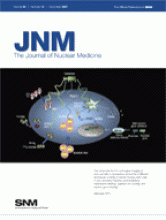This issue introduces “Focus on Molecular Imaging” as a new monthly feature of The Journal of Nuclear Medicine (JNM). Molecular imaging aims to visualize and measure fundamental biologic processes at the molecular, subcellular, and cellular levels. Molecular imaging promises not only to deepen our understanding of already-known biologic processes but also to uncover still-unknown molecular and cellular events that are at the center of the initiation and evolution of disease. Molecular imaging therefore offers a means for specific targeting of such abnormal biologic processes for diagnosis and treatment. Translated from the bench to the bedside, molecular imaging promises to play an important role in accounting for individual genetic and proteomic variations of disease and for personalizing not only the diagnostic strategy but also existing and emerging treatment approaches.
It is clear that molecular imaging is not the exclusive domain of a single imaging technology or field. In fact, the integrated application of a broad range of technologies for producing image signals has contributed to its rapid growth and successes. Besides the use of targeted radionuclide probes in nuclear medicine, molecular imaging includes target-specific paramagnetic and superparamagnetic ligands for MRI and MR spectroscopy, fluorescent dyes for optical imaging, and microbubbles for ultrasound imaging. There is also an ever-increasing number of target ligands (from proteins to antibodies, affibodies and minibodies, and nanoparticles, to name only a few) and of detection devices for their visualization. Various imaging modalities may probe the very same process or, more often, different aspects or parts of the same biologic process. Information gained through multimodality imaging may more comprehensively and completely delineate and characterize the biologic process under investigation. Multimodality imaging approaches are no longer confined to basic research; they have been brought to the bedside, as is evident from the increasing use of hybrid imaging such as PET/CT, SPECT/CT, and—perhaps in the future—PET/MRI. Integrated multimodality imaging in clinical practice has substantially improved the accuracy with which disease can be detected and quantified. It has also refined measures for monitoring responses to treatment and provided a means for improved disease targeting and outcome prediction.
The success of multimodality imaging in both basic and clinical research will likely depend on a closely integrated multidisciplinary approach with experts in the fields of biochemistry, bioinformatics, biomathematics, cellular/molecular biology, organic chemistry, material sciences, nanotechnology, genetics, bioengineering, optics, medical imaging, medical physics, pharmacology, radiation oncology, and many others. The fact that specialists will need to collaborate ever more closely in the future and become better informed about molecular imaging has served as motivation to introduce a new feature in JNM. Beginning with this issue, JNM will publish one article each month in a special section called “Focus on Molecular Imaging.” These articles will familiarize readers with the methodologic aspects of various molecular imaging approaches, those molecular and cellular processes that are at the heart of current investigative efforts, and the implications of biologic processes for identifying human diseases and targets for therapeutic strategies and therapy response monitoring. JNM remains committed to providing a forum for the exchange of emerging ideas and to encouraging new and innovative collaborations, as is clearly evident in the first “Focus on Molecular Imaging” article, “Comparison of Imaging Techniques for Tracking Cardiac Stem Cell Therapy,” written by Sarah J. Zhang and Joseph C. Wu of Stanford University.
Footnotes
-
COPYRIGHT © 2007 by the Society of Nuclear Medicine, Inc.
-
DOI: 10.2967/jnumed.48.12.1915.07







